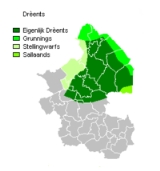
Drents
Encyclopedia
Drèents is a collective term for the dialect
s spoken in Drenthe
, a province
of the Netherlands. The dialects, which are still spoken by half the population of Drenthe, are Dutch Low Saxon
variants.
, the dialects from the south-west are 'Stellingwerfs', and the dialects in a few villages along the southern border with the Grafschaft Bentheim
(Germany
) are considered to be Sallaans (because they have an umlaut
in the diminutives).
The foundation Stichting Drentse Taol distinguishes seven main variants of Drèents within the province, based upon the research made by G.H. Kocks, the main editor of the Woordenboek der Drentse Dialecten (Dictionary of the Drèents Dialects):
It also can be divided into Midden-Drents and Zuid-Drents.
Dialect
The term dialect is used in two distinct ways, even by linguists. One usage refers to a variety of a language that is a characteristic of a particular group of the language's speakers. The term is applied most often to regional speech patterns, but a dialect may also be defined by other factors,...
s spoken in Drenthe
Drenthe
Drenthe is a province of the Netherlands, located in the north-east of the country. The capital city is Assen. It is bordered by Overijssel to the south, Friesland to the west, Groningen to the north, and Germany to the east.-History:Drenthe, unlike many other parts of the Netherlands, has been a...
, a province
Province
A province is a territorial unit, almost always an administrative division, within a country or state.-Etymology:The English word "province" is attested since about 1330 and derives from the 13th-century Old French "province," which itself comes from the Latin word "provincia," which referred to...
of the Netherlands. The dialects, which are still spoken by half the population of Drenthe, are Dutch Low Saxon
Dutch Low Saxon
Dutch Low Saxon is a group of Low Saxon, i.e. West Low German dialects spoken in the northeastern Netherlands. In comparison, the remainder of the Netherlands speak a collection of Low Franconian dialects.The class "Dutch Low Saxon" is not unanimous...
variants.
Dialects of Drèents
All Drenthe dialects are classified as Dutch Low Saxon. The dialects from the north and the east (see below: 'Noordenvelds' and 'Veenkoloniaals') are usually considered to be GroningsGronings
Gronings, in the dialect itself called Grunnegs or Grönnegs, is a collective name for some Friso-Saxon dialects spoken in the province of Groningen and around the Groningen border in Drenthe and Friesland. Gronings and the strongly related varieties in East-Frisia have a strong Frisian influence...
, the dialects from the south-west are 'Stellingwerfs', and the dialects in a few villages along the southern border with the Grafschaft Bentheim
Bentheim
County of Bentheim is a district in Lower Saxony, Germany. It is bounded by the Dutch provinces of Overijssel and Drenthe, the district of Emsland, and the districts of Steinfurt and Borken in North Rhine-Westphalia.- History :The District has roughly the same territory as the County of...
(Germany
Germany
Germany , officially the Federal Republic of Germany , is a federal parliamentary republic in Europe. The country consists of 16 states while the capital and largest city is Berlin. Germany covers an area of 357,021 km2 and has a largely temperate seasonal climate...
) are considered to be Sallaans (because they have an umlaut
Germanic umlaut
In linguistics, umlaut is a process whereby a vowel is pronounced more like a following vowel or semivowel. The term umlaut was originally coined and is used principally in connection with the study of the Germanic languages...
in the diminutives).
The foundation Stichting Drentse Taol distinguishes seven main variants of Drèents within the province, based upon the research made by G.H. Kocks, the main editor of the Woordenboek der Drentse Dialecten (Dictionary of the Drèents Dialects):
- Noordenvelds
- Veenkeloniaols
- Zuudoost-Zaand-Drèents
- Zuudoost-Veen-Drèents
- Midden-Drèents
- Zuudwest-Noord-Drèents (Also see StellingwarfsStellingwarfsStellingwarfs is the form of Dutch Low Saxon spoken in Ooststellingwerf and Weststellingwerf in the Dutch province of Friesland.By some observers included within Stellingwarfs is Veenkoloniaals, which is spoken in the village of Noordwolde in the Dutch province of Friesland.Stellingwarfs is easily...
) - Zuudwest-Zuud-Drèents
It also can be divided into Midden-Drents and Zuid-Drents.
Examples of usage
| Emmen dialect: | We moet'n nie zo haast'n. |
| Standard Dutch: | We hoeven ons niet zo te haasten. |
| English: | We do not have to hurry. |
| Northern Drenthe: | ain | twai | drai | vaier | vief | zes | zeum | aacht | neegn | tien |
| Southwest Drenthe: | iene | tweie | dreie | veere | vieve | zesse | zeum | achte | neegn | tiene |
| Standard Dutch: | een | twee | drie | vier | vijf | zes | zeven | acht | negen | tien |
| English: | one | two | three | four | five | six | seven | eight | nine | ten |

